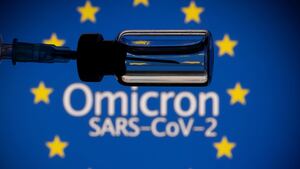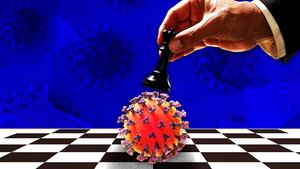The new Omicron variant of the novel-coronavirus is, at first glance, pretty frightening.
With more mutations compared to other variants—“lineages” is the scientific term—Omicron has the potential to be more transmissible. And as with all new lineages, there’s a chance it might partially evade the COVID-19 vaccines, potentially thwarting to some degree our best defense against the virus and setting us back as the pandemic enters its third year.
Startling headlines and cable-news chyrons interrupted the weekend. “Omicron” trended on social media. Some pundits predicted doom. The U.S. stock market dropped more than two points in a single day—its worst dip since February. (Stocks have since recovered.)
But looks can be deceiving. There’s no firm evidence yet that Omicron is any worse than the lineage that’s currently dominant: Delta. Indeed, Delta is so nasty it might outcompete Omicron in many countries and slow, if not halt, the new lineage’s spread.
And as far as we know, the vaccines still offer historically high levels of protection against Omicron, even taking into account the lineage’s possible vaccine-evasive qualities. In other words, we probably already have the tools we need to deal with Omicron. Vaccines. Boosters.
President Joe Biden got it right on Monday when he urged calm. Omicron, Biden said, is “cause for concern, not a cause for panic.”
Scientists in South Africa were the first to identify Omicron amid a spike in infections over the last two weeks. The country registered fewer than 300 new COVID cases on Nov. 16. A week later, it counted nearly 19,000 new cases in a single day.
Genetic sequencing revealed a new lineage. Compared to older lineages, Omicron features around 50 key mutations, some 30 of which are on the spike protein that helps the virus to grab onto our cells. Some of the mutations are associated with a virus’ ability to dodge antibodies. Others are associated with higher transmissibility.
The South Africans sounded the alarm over the Thanksgiving weekend. The World Health Organization convened an emergency meeting on Friday, but WHO experts lacked the data to draw firm conclusions.
“It is not yet clear whether Omicron is more transmissible,” the WHO stated. Likewise, “It is not yet clear whether infection with Omicron causes more severe disease compared to infections with other variants, including Delta.”
Yes, cases are spiking in South Africa, but that might not be Omicron’s fault, the WHO noted. Cases are spiking all over the world, even in countries with no confirmed Omicron cases. “Preliminary data suggests that there are increasing rates of hospitalization in South Africa, but this may be due to increasing overall numbers of people becoming infected, rather than a result of specific infection with Omicron,” the WHO explained.
Now the good news. “There is currently no information to suggest that symptoms associated with Omicron are different from those from other variants,” the WHO stated. Angelique Coetzee, chair of the South African Medical Association, told Reuters that the Omicron patients she’s seen have suffered “very mild” symptoms.
Even better news: “The data from South Africa suggests that double-vaccination is still holding against Omicron,” Edwin Michael, an epidemiologist at the Center for Global Health Infectious Disease Research at the University of South Florida, told The Daily Beast.
Until we know more, the WHO stressed that “current vaccines remain effective against severe disease and death.” Leading vaccine-makers including Pfizer and Moderna promptly announced plans to quickly modify their respective vaccines to better handle Omicron, in the event the lineage evades the current jabs to any significant degree.
In the days following Omicron’s emergence, many countries curtailed travel from South Africa and neighboring countries. But it might already be too late to halt the lineage’s spread. “Travel restrictions may or may not prove to be useful,” Irwin Redlener, the founding director of Columbia University’s National Center for Disaster Preparedness, told The Daily Beast.
Health officials have found Omicron in Israel, the United Kingdom, Canada, and other countries. There are no confirmed cases in the United States yet, but there surely will be soon. “I think we see it everywhere,” Christopher Mason, a biophysicist at Weill Cornell Medicine in New York, told The Daily Beast.
In the worst-case scenario, a more transmissible, vaccine-evading Omicron could further accelerate a seasonal increase in COVID cases that’s already underway in the northern hemisphere as the weather cools and people crowd indoors.
Ironically, the Delta lineage that’s currently dominant could, in many countries, function as a bulwark against Omicron. Different versions of the SARS-CoV-2 pathogen compete with each other for hosts. Delta has out-infected other lineages, which is how it became so widespread.
It’s possible that a combination of vaccinations, immunity from prior infection, and current Delta infections might crowd out Omicron in a lot of places, eventually blocking its transmission. To whatever extent Omicron ends up producing worse outcomes compared to Delta—more hospitalizations, more deaths—it’s good news if Delta beats out the new lineage. “My hunch is that this will turn on how more contagious Omicron will be in relation to Delta,” Michael said.
Of course, Omicron’s rapid spread in South Africa might indicate that the new lineage is capable of outrunning older lineages in the race for human hosts. But some scientists suspect South Africa and neighboring countries might be uniquely vulnerable to new coronavirus lineages owing to their low vaccination rates and large HIV-positive populations.
HIV suppresses the immune system, making an infected person more vulnerable to all kinds of viruses. South Africa has the highest rate of HIV in the world. A fifth of the population carries the virus, creating opportunities for SARS-CoV-2 that might not be present in populations with lower rates of HIV. Only 0.3 percent of Americans are HIV-positive.
“The relatively high rates of HIV in the African continent means that the virus could mutate freely even in a single individual who simply cannot clear the COVID-19 virus,” Lawrence Gostin, a Georgetown University global-health expert, told The Daily Beast. “The interconnected epidemics of HIV and COVID-19 is a major problem in Africa and for the world.”
“But vaccine hesitancy does play a role,” Gostin added. Owing in part to strong anti-vax sentiment, South Africa has fully vaccinated less than a third of its 59 million people. For comparison, the United States has fully vaccinated 60 percent of its 330 million.
Not only is South Africa’s large unvaxxed population especially vulnerable to Omicron, but it might also be the reason Omicron exists in the first place. Every infection is an opportunity for the virus to evolve. “New variants arise because we have too many people across the globe that remain unvaccinated,” Aimee Bernard, a University of Colorado immunologist, told The Daily Beast.
In the United States and other countries where HIV rates are low, solid majorities of the population are vaccinated and a wide array of post-infection COVID therapies—including a highly-effective antiviral pill from Pfizer—are available, this winter’s surge in novel-coronavirus infections so far hasn’t been accompanied by a surge in deaths. The virus is slowly becoming “endemic”—that is, always present but generally manageable.
With a little luck, Omicron won’t have much effect on this dynamic across much, if not most, of the world. And if scientists gather more data and discover that Omicron actually is a serious problem, there’s an obvious solution.
The vaccines, which in the United States and other richer countries are safe, effective, free, and readily available. True, Omicron’s mutations might compel pharmas to slightly tweak their formulations. Then again, they might not.
In any event, no one expects the new lineage to totally evade the vaccines. “It is highly likely that individuals who are fully vaccinated and have received their booster are at much lower risk for infection and severe disease than those who remain unvaccinated,” Anthony Alberg, a University of South Carolina epidemiologist, told The Daily Beast. “Even if the protection from the existing vaccines is much lower for the Omicron SARS-CoV-2 variant compared with previous variants, it is likely to confer some degree of protection.”
Omicron might turn out to be no big deal. But if you’re worried and unvaccinated, now is a good time to get jabbed. If you’re vaccinated, get boosted. If you’re boosted, relax… and wait for more information.
Ali Mokdad, a professor of health metrics sciences at the University of Washington Institute for Health, said more data on Omicron should arrive quickly. “We need a week or two to understand the full impact.”









